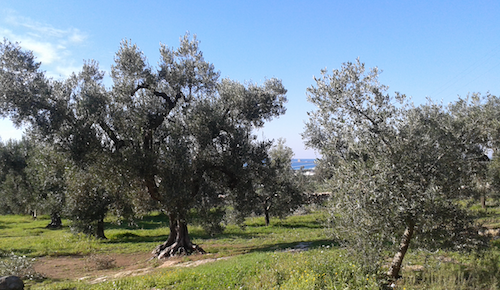
Over the past 60 years increasing water demand, population growth, urban expansion, and intensive agricultural practices in many areas have exacerbated the impact of water scarcity and droughts for irrigation purposes.
In several regions, but especially in semi-arid areas, raising frequency, duration and intensity of drought events, mainly driven by climate change dynamics, are expected to dramatically reduce the current stocks of freshwater resources, limiting crop development and yield especially where agriculture largely depends on irrigation. In the drought-affected regions of the Mediterranean basin (i.e. Spain, Malta, Italy, Greece, Turkey) the impacts of climate change on water yields are already happening. In Puglia Region, for example, hot and dry climate with increasing variability of the rainfall patterns and intensity (heavy rains during the fall/winter period and severe droughts in summer) pose serious problems to the (competitive) use of water resources.
The achievement of an affordable and sustainable equilibrium between available water resources and irrigation demand is essentially related to the planning and implementation of evidence-based adaptation strategies and actions.
A study recently published on Advances in Water Resources (among the authors, CMCC researchers P. Ronco, S. Torresan, A. Critto, M. Santini, A. Trabucco, A. L. Zollo, G. Galluccio, A.Marcomini) assessed the potential water scarcity risk, due to changes in climate trends and variability, on irrigated croplands.
The new methodology has been tested over the irrigated areas in Puglia Region, where crops are mainly olive groves, vineyards, fruit trees and vegetables, with a special focus on three Reclamation Consortia that manage the distribution of water for irrigation purposes: “Consorzio per la Bonifica della Capitanata”, “Consorzio di Bonifica Terre d’Apulia”and “Consorzio di Bonifica Stornara e Tara”.
Regional climate projections, under alternative greenhouse gas concentration scenarios (RCP4.5 and RCP8.5) and for two different timeframes, 2021–2050 and 2041–2070 compared to the baseline 1976–2005 period, have been used to drive hydrological simulations of river inflow to the most important reservoirs serving irrigation purposes in Puglia.
Results have showed that for the most pessimistic emission pattern (RCP8.5), a not negligible portion of agricultural (irrigated) areas are at high risk of water scarcity induced by climate change, especially in long-term perspective, with considerable economic losses associated. In fact, a considerable decrease on the productivity of the fruit trees, vegetables and, to lower magnitude, vineyards (the most valuable crops in terms of revenue per hectare), is expected. By contrast, olive groves are projected to be less vulnerable, and therefore more resilient, to the scarcity of water. In a long-term perspective, is very likely that this crop will increase its coverage. Besides being more resilient, olive groves seem recently affected by biotic disturbances (bacterium such as Xylella fastidiosa ) on which the influence of climate disturbance, although more indirect, has not to be excluded as complementary threat from climate change.
The study explored the vulnerability of crops of water stresses, but also the degree of efficiency-system losses and the degree of diversification of water sources.
Risk maps and related statistics distinguishing the most critical areas (risk hot spots) show that the areas more at risk are located in the middle-southern Puglia (within the Stornara and Tara Consortium). In fact, this Consortium presents a high percentage of vegetables and fruit trees (the most vulnerable crops), with a relatively high rate of system losses and no water sources diversification. The northern-middle Puglia (Capitanata and Terre d’ Apulia Consortia) is characterized by a lower vulnerability mainly because of the greater presence of vineyards and olive groves (more tolerant to water stress) and, moreover, Terre d’ Apulia Consortium relies on diversification of water sources.
Based on the outcomes of the study, tailored and knowledge-based adaptation strategies and related actions can be developed, to reduce the risk at both agronomic level (i.e. preferring crops with low vulnerability score, as olive groves) and at structural level (i.e. differentiating the water stocks and supplies and reducing losses and inefficiencies) while achieving an affordable and sustainable equilibrium between available water resources and irrigation demand.
The study has been realized in the framework of ORIENTGATE project activities. Four CMCC divisions, that is RAAS, IAFES, REMHI and Fund Raising, have been involved in the study, in the person of CMCC researchers Paolo Ronco, Silvia Torresan, Andrea Critto, Monia Santini, Antonio Trabucco, Alessandra Lucia Zollo, Giulia Galluccio and Antonio Marcomini.
The CMCC, with technical and advisory support of ORIENTGATE-SEE partners, coordinated data collection, produced climate projections by modelling and downscaling, as well as handling relationships with relevant stakeholders and end users.
For further information, read the integral version of the paper:
Ronco P., Zennaro F., Torresan S., Critto A., Santini M., Trabucco A., Zollo A. L. , Galluccio G., Marcomini A.
A risk assessment framework for irrigated agriculture under climate change
2017, Advances in Water Resources, DOI: DOI: 10.1016/j.advwatres.2017.08.003


